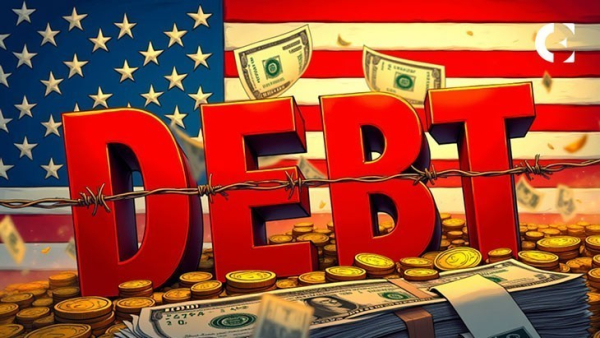US National Debt to Reach $38 Trillion by 2025: Will Bitcoin Be the Best Hedge Against Dollar Devaluation in 2025?

As of October 2025, US national debt exceeded $38 trillion, representing the fastest increase in sovereign borrowing by $1 trillion recorded outside of the COVID-19 pandemic. As investors grapple with how this will impact the long-term stability of the dollar, attention is once again turning to Bitcoin and other alternative assets that promise protection against dollar depreciation and inflation.
Could 2025 finally be the year Bitcoin fulfills its role as the perfect hedge, or is its reputation as an inflation hedge still more a matter of hope than demonstrated effectiveness?
The US government debt crisis is deepening.
The large and rapid accumulation is likely due to several factors, such as persistent budget deficits, rising interest costs caused in part by Federal Reserve rate hikes, an aging population, and large amounts of money spent on military and social programs.
Additionally, according to the Peter G. Peterson Foundation, rising interest payments have exceeded $880 billion annually and are projected to exceed $1.8 trillion by 2035.
Economists warn that the US debt-to-GDP ratio (currently approaching 124%) is on a dangerous trajectory. They note that while the country's economy was at similar levels during wartime, the current situation is not characterized by the massive economic boom that typically follows such massive spending.
On the topic: Bitcoin price follows CPI data: will inflation trigger another surge or decline?
US National Debt by Year
To illustrate how the debt situation has changed, here's a breakdown of the US government debt by year, including approximate totals and the main reasons for the increase:
| Year | Debt (approximate) | Main reason(s) |
| 2021 | $28.42 trillion | COVID-19 Relief Costs |
| 2022 | $30.93 trillion | Inflation Reduction Act |
| 2023 | $33.17 trillion | Higher borrowing costs due to rising interest rates |
| 2024 | $35.46 trillion | Credit rating downgrade |
| 2025 | $38.00 trillion | Record spending rates, an aging population, defense budgets, high interest rates on loans |
$38 trillion debt fuels fears of dollar depreciation
When government debt grows faster than GDP (as is the case with the US government debt in 2025), it often leads to monetary expansion, which effectively means printing more dollars to cover budget deficits. However, over time, this reduces the purchasing power of the currency.
While inflation remains under control in 2025 compared to its 2022 peak, core inflation exceeds 3% (higher than the Federal Reserve's 2% target), and real wage growth is stagnating. The real problem now is not a sharp spike in inflation, but a slow, steady decline in the value of the dollar, as more and more tax revenue is spent solely on paying interest on the government debt.
This has sent investors scrambling for safe havens again, turning to assets such as Bitcoin, gold and government bonds to protect against rising prices.
Bitcoin Scarcity: The Case for Hedging Against Devaluation
Bitcoin's appeal lies in its fixed supply of 21 million coins, making it immune to dilution through money printing.
Proponents believe that Bitcoin's limited supply makes it a powerful tool for protecting wealth when governments print more money. This feature is considered particularly valuable during periods when central banks are forced to issue large amounts of new currency.
Over the past decade, Bitcoin's price dynamics have often responded positively to increased liquidity. For example:
- Following the COVID-19 stimulus measures (a form of quantitative easing) passed in 2020, Bitcoin's price rose from $9,000 to over $60,000 by 2021.
- On the other hand, when interest rates were raised (quantitative tightening) in 2022 and 2023, the value of Bitcoin fell sharply, as did the stock market.
This pattern defines Bitcoin as an asset whose value depends on monetary liquidity (especially since the US national debt is constantly growing year after year). Although it has not yet achieved the status of a traditional safe-haven asset like gold, its dynamics are increasingly correlated with the policies of global central banks.
In general, Bitcoin tends to rise when inflation expectations rise but liquidity remains high. It struggles during periods of tight monetary policy, when risky assets are simultaneously sold off. Therefore, Bitcoin is best suited as a hedge against depreciation when there is cash flow, rather than when rates are tight.
Read also: BlackRock CEO Larry Fink calls Bitcoin a 'hedge against devaluation' as IBIT surpasses 781,000 BTC
Institutional Adoption Through ETFs Strengthens Bitcoin's Legitimacy
This year, in addition to the 2025 rise in US national debt, increased activity by major financial firms has made Bitcoin a more prominent player in the global economy, boosting its perceived legitimacy. This month alone has seen several interesting developments related to institutional adoption.
For example, investment giant T. Rowe Price, which manages $1.77 trillion in assets, recently filed to create an actively managed crypto exchange-traded fund (ETF). Earlier, VanEck and BlackRock launched spot crypto exchange-traded funds (ETFs), which attracted billions of dollars in a matter of weeks.
Related: T. Rowe Price, a $1.77 trillion asset manager, wants to launch an active crypto ETF. Here's what it's tracking.
A few days ago, VanEck also filed for an Ethereum staking ETF pegged to Lido's stETH, aiming to provide investors with a regulated vehicle for gaining exposure to liquid staking tokens.
The recent surge in ETF applications (over 155 crypto ETF applications are pending approval by the U.S. Securities and Exchange Commission (SEC)) and their subsequent regulatory approval through products like Spot Bitcoin ETFs are fundamentally changing the nature of Bitcoin. It is transforming from a niche interest for individual investors into a fully-fledged asset class for major financial institutions, similar to what happened to gold after it launched its own investment funds twenty years ago.
Related: XRP and Solana Lead with 155 ETF Filings amid Growing SEC Filing Volume
Skeptics believe Bitcoin is not yet a true hedge
Despite the progress, critics argue that Bitcoin continues to behave like a tech asset, closely tracking the Nasdaq rather than gold.
Financial commentator Peter Schiff and economist Nouriel Roubini argue that Bitcoin's volatility makes it an unreliable safe haven. Furthermore, the recent liquidation of over $700 million in cryptocurrency leveraged positions demonstrates that speculative trading continues to drive market activity.
At the same time, even though the US national debt has increased by 2025, the US Dollar Index (DXY) remains high, suggesting that international confidence in US debt and the liquidity of its Treasury market has not diminished, at least for now.
Related: Digital Gold or Real Gold? Peter Schiff's Case Against Bitcoin Gains Momentum
Outlook: US government debt and Fed policy play key roles in Bitcoin hedging
Bitcoin's path in the remaining months of 2025 depends largely on three factors: how much more debt the US takes on, what the Federal Reserve does with interest rates, and how investors view risk.
If government debt spending forces the Fed to inject cash into the economy again, Bitcoin's price could rise sharply. However, if the Fed keeps rates high to combat inflation, this could cool the market.
Despite this short-term uncertainty, Bitcoin's core argument—that it protects wealth when governments print too much money—is becoming increasingly compelling. As the US sinks deeper into debt, more individuals and large funds are seeking assets that can withstand the potential consequences.
Ultimately, the US national debt of $38 trillion by 2025 is a warning sign that goes beyond mere overspending – it points to a deeper problem with a financial system built on constant borrowing.
For those who can handle the risk and volatility, Bitcoin could be a potential hedge against the dollar's decline.
On the topic: Gold jumps first, Bitcoin often follows at the 80-day mark – analyst
Source: cryptonews.net



